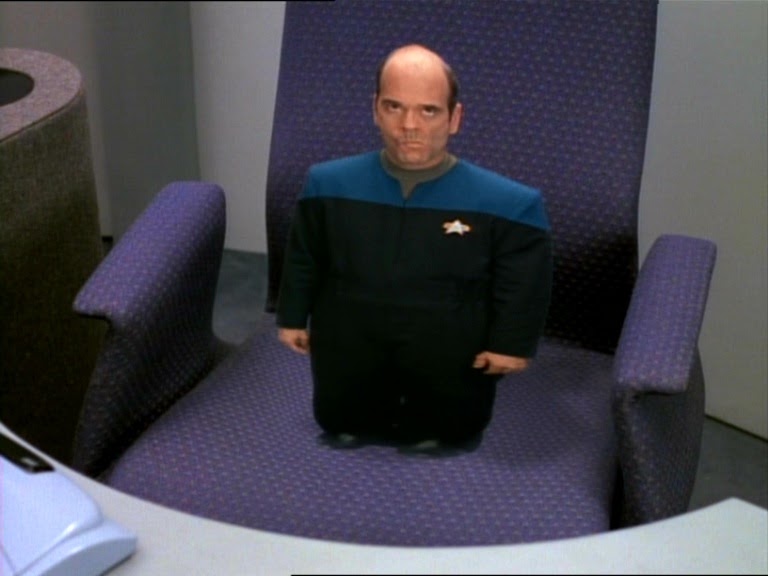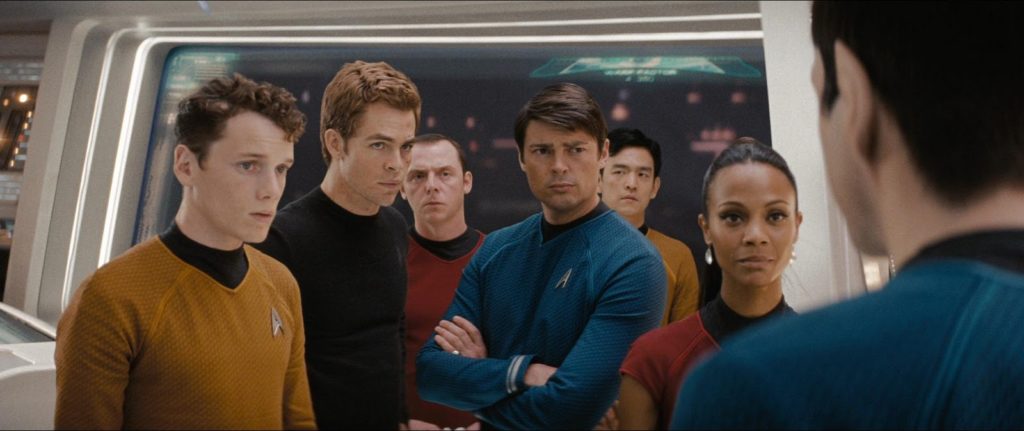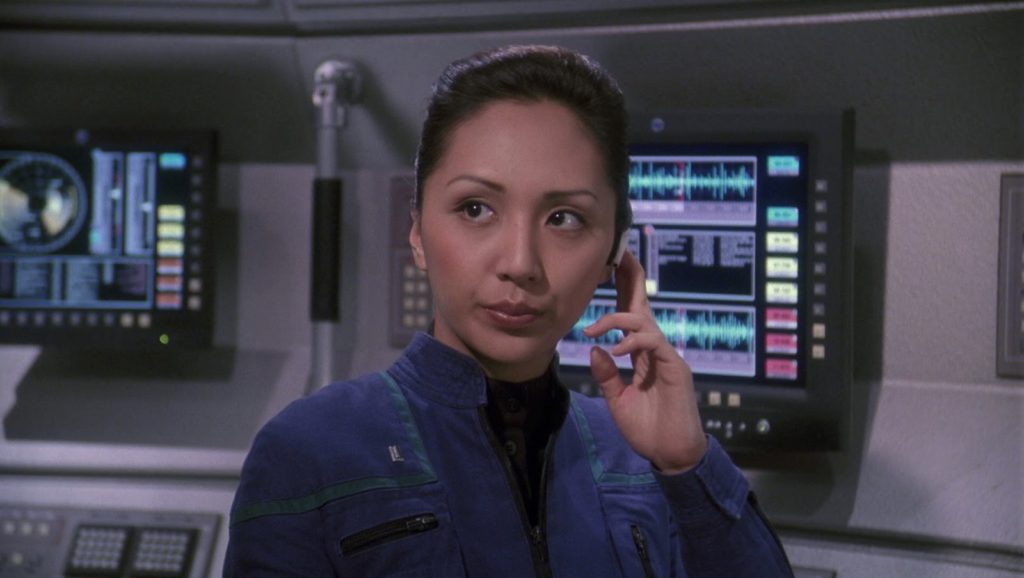Remember dead zones? Once upon a time, in any manner of environs, your service would, seemingly at random, completely disappear. You’d be going about your business, chatting with an in-network friend, someone in your Top 5 perhaps, about a recently updated Jersey Shore fan-blog, and your Blackberry just drops your call! No, neither phone has died—you’d entered a, where nary a single, solitary bar was ever to be found. To make it worse, from approximately 2004 to 2009 there was not only incredibly shoddy cell service, but also absolutely no new Star Trek.

Now, as I understand it, all Trekkies suffered at this time, but I would like to hold space at this time for those of us who hadn’t really gotten the chance to have new Trek as young people, only reruns and the J.J.-verse. Trekkies born in the 1990s, like me, arrived at a time of greatness, even if we didn’t really have an ability to understand it yet. Personally, I have the profound honor of being able to say that some of my earliest childhood TV memories are of the Doctor’s holo-emitters malfunctioning and B’Elanna struggling with her own anti-Klingon-ness when it comes to her daughter. But while I appreciate the nerd cred (I’m lucky enough to have technically seen Nemesis in the theaters, but to have forgotten almost everything about it), even if I’m the only one impressed by it, there’s something to be said for just missing one of the most important chapters in Star Trek history.
 Like any self-respecting third-generation Trekkie, I can at least remember the vague idea of watching the pilot of Enterprise as a family, but it loses meaning when you were seven, and your parents never got into the show. Kind of like having a memory that Worf’s wife dies at some point on DS9, but you don’t know when, where, how, or even who she is. Imagine, if you will, a world where Jadzia Dax is primarily defined as Worf’s wife. While I was brought up knowing the value of Trek, it was still hard to see myself as a Trekkie, as all I really had were a few fuzzy memories and TNG reruns. This was then complicated by my re-entry into Trek fandom, because I got back into Trek due to Star Trek (2009). And, well, “real fans” aren’t supposed to like the J.J.-verse.
Like any self-respecting third-generation Trekkie, I can at least remember the vague idea of watching the pilot of Enterprise as a family, but it loses meaning when you were seven, and your parents never got into the show. Kind of like having a memory that Worf’s wife dies at some point on DS9, but you don’t know when, where, how, or even who she is. Imagine, if you will, a world where Jadzia Dax is primarily defined as Worf’s wife. While I was brought up knowing the value of Trek, it was still hard to see myself as a Trekkie, as all I really had were a few fuzzy memories and TNG reruns. This was then complicated by my re-entry into Trek fandom, because I got back into Trek due to Star Trek (2009). And, well, “real fans” aren’t supposed to like the J.J.-verse.
Luckily, with the advent of Netflix’s “instant queue,” as it was known then, I was able to catch up with Trek from 1987 onward. To insecure baby-Trekkie me, this provided a sense of canon that I now find irreplaceable. I would argue that because I watched things back to back over the course of two or three years, I got a better sense of how things connect than if I’d watched them as they originally aired. Better yet, what started as a desire to justify calling myself a fan turned into an understanding that I’m a fan because I like Trek, not because I’ve watched the Original Series seventeen trillion times.
Now that we’re in the midst of a true Trek renaissance, I’ve begun to reflect on what the late ‘00s and early ‘10s Trek dead zone really meant to me as a fan. A friend of mine recently got into Discovery, and casually floated the idea that he’d start Picard. Being the upstanding Trekkie that I am, I took a deep breath and tried to analyze, objectively, how much TNG (and Voyager) I could possibly force him to watch before he’d revolt. He’s been a good sport so far, but in our discussions about how much TV budgets and pacing have changed in thirty years, there’s a certain amount of “why bother with this, when I can get the new stuff?” mentality. Frustrating, sure, but I get it.

When I started what is possibly the first great Netflix binge of my lifetime, I was tasteless enough to start with Enterprise. To be honest, this was simply because I knew the special effects would be better, but I’ve got to be real with you; I quit watching the Original Series because I was just plain bored, and couldn’t be bothered to rewind when I missed something in minute twenty-three that turned out to be important at minute forty-nine. It’s hokey and they take a million years to get anything done. Maybe not coincidentally, my friend says similar things about TNG.
In a way, I’m grateful for the dead zone, because instead of starting with the shiny, new shows, I was able to ground myself in ‘90s Trek at a very important period in my life. I know for a fact that I wouldn’t have the strength of will to watch all that Trek now: Partially because the “too much good TV” cliche is real, but also because I’m at a different developmental stage in life. Kids, but particularly older teenagers, have a lot of time to develop their hobbies that adults just don’t. Once 3G became a thing, I had all of Star Trek in my pocket, waiting for my bus ride home or when I volunteered in my mom’s classroom (to me, there is a strong connection between waiting for a copier to finish and Quark being obnoxious). By the time I’d finished high school, I knew exactly how Trek fit into my life, and why I loved it. Plus, because I wasn’t watching it for cloaked Starfleet headquarters or giant space battles, I actually get the Lower Decks jokes and have a burning passion for justice for Icheb.
While there were some pretty obvious drawbacks to coming of age in a Star Trek dead zone, I think I did pretty well for myself, all things considered. It certainly taught me the value of all the new stuff we’re getting, and yet has also helped me guide friends who might be interested in diving deeper into the franchise. Maybe, like Trekkies who’ve come before, folks of my cohort can help nurture this new generation’s passion for all of Trek, while having a realistic understanding of what past glory really means to current viewers.